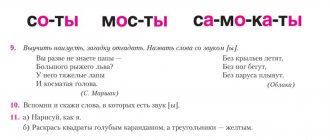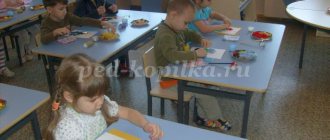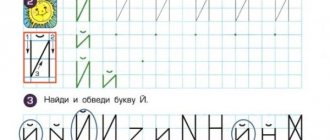Today I would like to talk about the very first games for teaching reading. They are suitable, first of all, for children who still cannot read at all ( you can play from 1.5-2 years old ), but, of course, they will also be useful for those who have already learned a little continuous reading.
I want to say right away that there will be no games here like coloring and modeling all the letters of the alphabet in turn from plasticine. In my previous article, I already wrote that a child who has memorized individual letters using the alphabet or in any other way subsequently experiences many difficulties in combining them into syllables. Therefore, I want to invite you to play not with letters, but immediately with words (MI, BUT, TU...) and short words. With this approach, the child constantly sees ready-made letter combinations before his eyes, plays with them, rearranges them, and, as a result, quickly remembers them . At first, only visually, then he tries to reproduce it himself. As a result, the child does not experience problems with merging letters; he immediately reads the letter. But, interestingly, during such games the child remembers all the letters.
What do you need for games?
So we will play:
- with warehouses (not to be confused with syllables)
The concept of a warehouse was introduced by Nikolai Zaitsev (creator of the well-known Zaitsev cubes). Unlike a syllable, which can consist of either 4 or 5 letters, a warehouse is considered a minimally pronounceable unit. The warehouse can be:
- fusion of consonant and vowel (YES, MI, BE...);
- a separate vowel as a syllable ( YA -MA; KA- YU -TA);
- a separate consonant in a closed syllable (KO- SH -KA; MA-YA- K );
- consonant with a soft or hard sign (Мь, Дъ, Сь...).
In the game you can use both Zaitsev's cubes and cards with warehouses written on them. I’m not going to try to persuade you to buy expensive Zaitsev cubes now. Yes, this is an interesting and useful manual, but if you do not have the opportunity to purchase them, do not worry, you can make a huge number of manuals at home with only cardboard and markers.
- with words written according to the warehouse principle.
You can either write words by hand with a felt-tip pen or print them on a printer. So that the child sees not only the whole word, but also learns to analyze its composition, we will highlight warehouses in it. It is not advisable to separate warehouses using additional signs (separate them with dashes, circle them); it is best to highlight them in different colors. You don’t need to use all the colors of the rainbow; take two colors that are similar in shade, for example, blue and cyan or dark green and light green. You will also need black. We write the first warehouse in one color, the second in another, the next one in the first color again, etc. But! The shock warehouse is always highlighted in black, as it is heard “brighter”.
What words should I write on the cards?
- short (at first no more than 3-5 letters),
- simple (preferably consisting of frequently used letters, Ш and ъ will wait for now),
- familiar and interesting to the child.
The main essence of this approach to teaching reading is to show the child that letters and words are not meaningless squiggles, they represent very specific objects, and you can play with them just like with familiar toys.
Learning letters.
If a child has trouble remembering letters, the best way to learn them is to “revive” them, to create a vivid association with each letter. You and your child can come up with what this or that letter looks like, or use a variety of materials from the Internet and modern alphabet books.
For example, bright, memorable images of letters for children can be found in Elena Bakhtina’s primer (this book contains not only colorful pictures and recommendations on how to tell a child about each letter, but also colorful templates - letters from this primer can be cut out and played with) .
On the Internet, you can find a lot of coloring pages for children with letters similar to this or that object.
It is also useful in the process of learning letters to repeat short verses that help you remember each letter:
You see the tail at the end, so this is the letter C.
The letter B is like a hippopotamus - She has a big belly!
G looks like a goose - the whole letter is bent.
D - a tall house with a roof! This is the house we live in.
And the poor letter Y walks with a stick, alas!
In my work, I use various “reminders” that children associate with one or another letter. You can actively use them in home lessons or come up with your own.
It is very useful to have a special notebook or album in which the letter you have learned will “live” on each page. In this album you can also teach your child to write, paste pictures with words on the desired letter, add poems and coloring pages, creating a selection of materials for each letter. Children are very fascinated by the process of joint creativity, so actively involve them in creating such an album.
Another option is to make a letter house. Choose any size: it can be very small, made from a couple of cardboard sheets, or huge, as tall as a child. The main thing about it is the special pocket windows for letters. In each “apartment” of the letter house, place a letter with your child. To do this, you will need cardboard letters slightly smaller than each window. Mark in any way which apartments already have “residents” and which ones are still empty.
Attach the already learned letters to the outside of the windows (using paper clips) and invite the child to arrange pictures with words into the studied letters in the windows. For example, “treat” the letters: give the child images of products that he must distribute to the desired “apartments”: put a watermelon/apricot in the window with the letter A, a loaf, an eggplant - in the window with the letter B, waffles / grapes - with the letter B and etc.
Similarly, you can visit letters with fairy-tale characters (Pinocchio - to the letter B, Thumbelina - to the letter D, Mowgli - to the letter M, etc.), “dress” the letters (take the T-shirt to the letter F, jeans to the letter D, pants - letter Ш, etc.).
The main goal of this game is to teach the child to identify the first letter in a word and easily recognize letters already completed.
Various lotto and domino games are also great for learning letters. It is better to use lotto without picture prompts, this way learning will be much more effective. You can easily make such a lotto yourself. To do this, prepare sheets with 6-8 pictures on each and cardboard cards with the necessary letters. Let the child draw cards, read the letters and show which player has the picture for the dropped letter.
Basic principles of games
There is one very sure way to discourage a child from reading - this is to constantly test him: “Tell me, what letter is this?”, “Read what is written here!” Having shown a letter to a child a couple of times, we expect that by the third time he will already name it, or even better, read the word with its participation. If you want to really interest your child in reading, then put off at least for a while trying to examine your child and just read with him!
It is natural that a child just beginning to become familiar with the world of letters cannot read a word. Therefore, when showing words to your child, do not require him to read, but at first read for him yourself! You can also trace the letters with your baby’s finger. After some time, the child will definitely begin to recognize words and phrases and will repeat them after you.
Sometimes a word needs to be read slowly, highlighting each word in it, sometimes it is necessary to name the entire word so that the baby learns to perceive the words as a single whole.
While reading, you can name individual letters (for example, if you don’t like the warehouse approach), but in this case it is advisable to pronounce not the name of the letter (“el”, “ka”), but the sound that corresponds to this letter (“l”, "To").
At what age to start
There are several opinions about what age you should start teaching your child to read fluently and meaningfully. Some teachers believe that you should start teaching your child before school, others - when the child enters 1st grade, and some - at an even older age.
In the beginning, experts advise teaching your child to read syllable by syllable.
According to the methods of Zaitsev, Doman, Montessori
The optimal period is considered to be from 3 to 7 years. The brain of a preschooler or first-grader remembers information quickly and firmly.
According to the Waldorf school
To firmly master the skill, children must grow to 10–12 years of age. This is due to the fact that elementary school students perceive information well when spoken at a normal speech rate. By intermediate level, the ability to understand rapid streams of phonemes will improve. Reading technique is accelerated.
Having combined and analyzed both opinions, we can say for sure that it is not worth doing speed reading with first-graders and preschoolers persistently, under pressure. It is better to postpone this until a later period, when the child is mature. In elementary school, use preparatory exercises to develop memory, attention, and articulation.
These classes are useful for increasing the pace of text assimilation in the future.
Important! For early learning of the alphabet and syllables, use Zaitsev's cubes. They can be used from 6 months of age to introduce letters in a playful way.
From simple to complex
Speed reading training is based on the ability to perceive words as a whole, without dividing them into syllables. At the initial stage, use short words consisting of two or three sounds. For example, “house”, “cat”. In the future, the baby will not read them or recognize them by letters. He will see this word in the text and immediately pronounce it. This is the meaning of the speed reading technique.
Preparation for the lesson: write the simplest words on a piece of paper, one at a time. Show them one after the other. As you complete the exercise, gradually increase the pace of changing words. Replace three-letter lexemes with words of four–five–seven letters after a solid assimilation of the material covered.
Words (“house”, “forest”) are replaced with complex ones (“tree”, “car”), then phrases and phrases. Compose sentences from vocabulary familiar to students. For example, he can read “who” and “house” separately. Suggest the phrase: “Who is in the house,” then add “lives” to this. You will get an offer.
You can start reading short texts when the student has mastered the ability to quickly read phrases and phrases. The pace of skill consolidation is different for all children. Do not rush if the student hesitates. Sometimes you need to return to simple, already covered material. This will increase interest in classes, reduce emotional stress, and set you up for success.
And only in this case will the fast reading technique produce results.
Important! For your first books, use bright literature, with pictures, and an interesting plot. A boring curriculum will not do.
Learning letters
There are different points of view as to whether it is right to memorize all the letters of the alphabet before starting to read. The author of the original methodology for teaching literacy N.S. Zhukova warns against such actions. The primer she developed is built in such a way that the child learns letters gradually. As the number of familiar letters increases, the syllables become more varied and complex, and then turn into words.
Magnetic ABC Zhukova
Parents who decide to follow one of the author's methods of teaching reading should follow the recommendations of their developers. And those who decide to teach their child to read the old-fashioned way don’t have much choice. They have to first memorize the alphabet, and only then start reading. It is advisable to show letters to a child from two to three years of age.
An original way to learn letters
An important point: the child learns consonant letters the way they are read in a word - without the “e” sound. The correct pronunciation is “r”, not “re” or “er”. If this rule is not followed, the child will begin to read the syllable “ra” as “rea” or “era”.
Learning letters is facilitated by their visualization. Cubes with letters, a magnetic alphabet, an interactive poster with the alphabet - any auxiliary equipment will come in handy. To begin with, the child needs to be taught to quickly search for the desired letter among those offered. Later, you can use it to lay out a letter from sticks or matches, sculpt it from plasticine and, finally, write it. For those who confuse letters, it would be correct to suggest that they feel their three-dimensional images with their eyes closed. Tactile sensations help memory.
You need to pay attention to the correct pronunciation of sounds
Tip: when learning vowels, it is important to pay the child’s attention to the sound reproduction pattern. For example, “A” means the mouth is wide open, “y” means the lips are like a tube, “e” means the mouth is stretched to the sides.
Didactic games for teaching reading to children 5-7 years old
Didactic games and exercises for teaching reading.
Didactic games and exercises for teaching reading to preschool children using information technology.
Author: Kraenkova Nina Nikolaevna, teacher of additional education of Central Television and Radio, Krasnoyarsk. Purpose of the work: didactic games are intended for children of senior and preparatory groups of kindergarten, additional education teachers, and parents. Goal: To create motivation in children to study at school. Objectives: 1.Develop cognitive activity. 2.Consolidate knowledge of letters and sounds. 3.Activate vocabulary 4.Cultivate the desire to achieve a positive result. Job description: Modern information technologies make reading learning accessible and interactive.
The child not only sees vivid, memorable images, but can also actively interact with the educational program. These games are aimed at creating motivation in the child to study at school. In exercises - games with letters, children repeat and consolidate their knowledge of letters and sounds, remember the spelling of printed letters - their image. The use of these games involves the development of logical thinking, memory, imagination, creativity, and curiosity in children aged 5-7 years. Exercises and games for teaching reading and memorizing letters are designed taking into account age characteristics and have different levels of difficulty. Some children cannot complete all tasks the first time. You can skip the task that caused difficulty and return to it later. Also, these games allow you to determine what causes difficulties for a child and individually select appropriate materials and exercises for him. Indeed, in preschool age, the level of development of a child often depends on who, how and how much works with him. There are several types of tasks in exercises - games with letters and syllables. The tasks use words well known to the child, consisting of 2-3 syllables. Syllables consist of two letters, a vowel and a consonant. As a rule, the child does not have any difficulties completing such tasks. Assignments can be supplemented at the discretion of the teacher. Game 1.
Fill in the missing letter and read the words.
Game 2.
Connect the syllables to form the word shown in the picture.
Game 3.
Connect the syllables with arrows and name what you get in one word.
Game4.
Make words from letters.
Game 5.
Make up the names of two flowers using letters.
Game 6.
Read the sentence, complete the words.
We recommend watching:
Games to develop the emotional sphere of a preschooler When is a child ready to read? Is your child ready to learn to read? Why can't a child learn to read?
Similar articles:
Alphabet learning games for children 4-5 years old
On the role of play in the development of preschool children
Functions of a didactic game for preschoolers
Texts for reading by syllables (for preschoolers and first graders)
Texts for reading by syllables (for preschoolers and first-graders)
FRIENDS
Ni-ki-ta and Le-sha are friends. They go to kindergarten together. Le-shi has a sa-mo-kat. And Nik-ki-you has a gun. Not real, but toy. These boys are great guys. O-ni always do-la-tsya ig-rush-ka-mi. And they never quarrel. The two of them play and laugh. It's good to be friends!
IN THE FOREST
It's good in the forest in the summer. The sun is shining, the birds are singing, all the animals are happy. Here is a red squirrel. She is gnawing nuts. Here is a laziness, he plucks grass and drinks water from the stream. And this is a bunny. He's hiding under a bush. Fi-lin is sleeping, and Li-si-tsa is close. Where is Mi-shka Ko-so-la-py? He ate too much and gasped.
Boots
In the morning, Vi-tya and Mi-tya got ready for the kindergarten. You stood up in your red bo-tin-ki, and tied your feet.
- A-it’s out of the way! -decided Vi-cha.
“Let’s do it,” agreed with Mi-cha’s brother.
Sa-dyat-sya with my mother in the bus. And the left Vi-tin bo-ti-nok got together with the right Mi-ti-nym, and oh-ba and sucked off his feet. Suck and swim through the puddle.
Vi-cha and Mi-ta are silently chatting, only their bare legs are squeezing under them. In the kindergarten everything is like that and ah-well: Vi-ti and Mi-tey have two bo-tin-ka on what-you-re-no-gi!.. Good-ro-sho, Pav -lu-shi for-pas-ny-e bo-tin-ki o-ka-za-lis, really, green-e. So all day long Vi-cha and Mi-tay walked around like clowns in the circus: one leg in a red boot, the other one - in the green!
Repeat the letter "SH"
We-sha-ta Ti-sha and Gla-sha - sha-lu-nish-ki. O-ni sha-li-li, sha-ri-li in the corners, shur-sha-li and found cheese, sprats and noodles. We arranged a feast.
Did you bring the cat Mur-ku to the feast?
Assistant.
Weaved a be-loch-ka kor-zi-nu. Weaved from and-in-the-twigs. No one has one in the forest: light-ka-ya, proch-na-ya, kra-si-va-ya.
All summer long the squirrel with the basket hasn’t come... Now the mushrooms are coming, now I’m here, now the grains are with... la.
One day I even found Skvor-chon in the grass. He fell out of the nest, and so he got lost.
He brought the be-loch-ka skvor-chon-ka home and straight into the basket of his do-mik us-tro-i-la.
On New Year's Eve, welcome your friends. How do you see her y-go-schen-e and ah-well: who do you b-loch-ka help?
- Basket! Basket! - Skvor-cho-nok shouted and sang as if spring had come to us.
What did the cat want to tell mom?
—The lazy cat got ready to go roaring. He went to Mama Kosh-ka to tell her about this, but didn’t say:
- Mommy, I love you!
-Ka-ki-e for-a-words! - Ma-ma Kosh-ka was excited. - But it will be better if you tell me how much you love me.
The cat didn't know how to show his love. He decided that sna-cha-la could ma-ma roll wool into a ball, from which he would knit it for him. a row of new and warm things! The balls were getting big, but he wasn't tired at all!
Then the cat started to work with him to sort out the bro-san's ku-bi-ki,
when suddenly we saw a sa-mo-kat in the corner. A beautiful thing came to his head.
Now he deftly walks on one paw and says that circus number ma-me!
The mice - the little ones were glad that the cat didn't go for a walk.
They were always bored without him. And instead, we had a lot of fun playing cat-and-mouse and running around the house! The lazy cat played honestly.
He never looked into the crack under the scarf or bit the mouse's tail.
The lazy cat started puffing. He drank fresh milk and thought about the fact that he didn’t know how you would fulfill Mother Cat’s request. He doesn't know how to show love.
But then he decided that Mama Cat would forgive him for-tit, because her request was difficult, and he only Little cat!
Za-yats and che-re-pa-ha (fairy tale)
Once upon a time, we spored for-yats and che-re-pa-ha, who quickly re-e-ed the forest-well-well about-be-lives. Che-re-pa-ha set off on her way, and the hare-egg lies under a bush, laughing: “Hurry, hurry, wh- re-pa-ha, ve-equal, I’ll talk to you about you.” But while he was wandering around like that, che-re-pa-ha - although she was walking quietly - she appeared at the target. I rushed behind her, but it’s too late. He knew how to run, but he didn’t know that, lying in place, he could get away from the mess.
What are you sisters
There lived sisters in the world: Zi-ma, Ves-na, Le-to and O-sen. Zi-ma by-la se-da-ya, be-la –ya. The weight was young, white-faced, in a green row, with blue eyes. Le-the-same in the green on-rya-de, behind-go-re-lo-e, behind-go-re-lo-e. And O-the shadow of evil-in-lo-sa-ya, in a red sha-li. Zi-ma, Ves-na and Le-to went to visit O-se-ni. On her table there is GRU-shi, and yab-lo-ki, and plum-you, and ar-bu-zy, and dy-ni, and white ka-ra-vai, and pa- whoops honey. Are the sisters going to bless O-sen? O-senior says: No, I must bless you. You, Zi-ma, ground the snow about-de-I-lo-at-the-wing, hid-la from De-da Mo-ro-za, you, Ves-na, po- let it rain-mi-li-va-la, you, summer, clear-but-sun-so-dry-la-lo, so that everything is ripe. Sisters and rads: We all worked hard so that people would get along with God.





